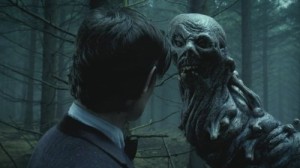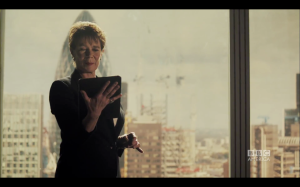The interior of the TARDIS is often discussed about a great deal, but is rarely shown. A bit of the TARDIS interior off the control room was shown in “The Edge of Destruction,” the Tom Baker story, “The Invasion of Time,” showed some of the interior and we saw what seemed to be endless corridors in “The Doctor’s Wife,” but “Journey to the Centre of the TARDIS” is the first story to really show off the wonders inside the TARDIS.
In an attempt to bring Clara and the TARDIS closer, the Doctor puts the TARDIS into basic mode, to give Clara a chance to fly her. Unfortunately, this makes the TARDIS vulnerable to some salvagers, who pull her on board their ship. The process they use to capture the TARDIS destroys her engines and causes chaos in her interior. The Doctor becomes separated from Clara and he must use the salvage crew to help him search for Clara, who is lost inside the TARDIS. Besides dealing with the greedy salvage team and a damaged TARDIS, the Doctor and the others must deal with the mysterious monsters that seem to be lurking around every corner.
This story was definitely an improvement over Steve Thompson’s previous story for Doctor Who, “The Curse of the Black Spot.” However, I have to admit that I was a bit disappointed with it. It wasn’t bad, but, for lack of a better way to put it, it was missing something for me. I’m not saying that I disliked it, but this one was probably an average episode. It wasn’t quite as good as “Cold War” or “Hide,” but it was definitely better than “The Rings of Akaten.” In some ways, I felt that the problem with the episode was that it was moving along a bit too quickly with too much going on. So much information is thrown at the viewer in this story that I feel that it requires multiple viewings to try to catch it all. I’ve already viewed it twice to try to take it all in, and I still don’t feel like I’ve caught everything, or else their just aren’t any explanations given.
It was nice to get a glimpse of some of the wonders inside the TARDIS: the swimming pool, the observatory, the Eye of Harmony, and, perhaps most interestingly, the library (although still not the wardrobe, which has always intrigued me). I have to admit that I was kind of hoping to see a little panda somewhere in one of the rooms (Does anyone else remember the poor, forgotten Hi-Fi?), but there were a few nice nods to the past. The Doctor’s baby bed, one of the seventh Doctor’s umbrellas, and one of Amy’s toy TARDIS are all spotted. The Galifrean encyclopedia was an idea I wish I could have seen more of, but the main attraction in the library was a book, The History of the Time War. Clara looks through the book in the library and it was obviously mean to tease the fans, who have many questions about the Time War. She learns something interesting from this book (Is that where she learned the Doctor’s name?), but, of course, we don’t get to know what.
At first I wasn’t sure about the monsters on the TARDIS. I couldn’t imagine how the Doctor was going to explain the creepy, charred monsters that were roaming around on his TARDIS. However, when I learned what they were, I found them to be an interesting twist. The idea that both the past and the future were bleeding through the small crack in time was a clever idea. The revelation that they were being chased by what remained of their former selves made the monsters more than just something thrown in to make the episode scarier. It was far more disturbing than simply having some kind of danger sneak aboard the TARDIS, and it was another secret for the Doctor to keep, since he clearly figured everything out much earlier in the episode. I wasn’t exactly sure why after being burned by the Eye of Harmony they would chase and kill their past selves, but your brain probably isn’t functioning at a particularly high level when you are basically burning to death.
The part of the story that I wasn’t really on board with was the story of the three salvage brothers. The idea that they had tricked their brother, who was really supposed to be the captain, into thinking he was an android, seemed like an unnecessary addition to the plot (although it does go along with the major theme, which I’ll discuss in a moment). And, how could he actually believe them? Didn’t he realize that he felt pain and emotions? When time was reset at the end, I was a bit confused about why things were going to be different between the brothers and just what that meant for the non-android brother, since he wouldn’t remember being told that he wasn’t an android. Clearly some of the emotional lessons they learned stayed with them, but what was their situation actually going to be now? The picture that was missing the third brother in the beginning of the story was now intact, but why? Did their past somehow get changed?
The theme of this story seemed to flow from the theme in “Hide” the previous week. This story seemed to be all about the value (or lack thereof) of secrets. The Doctor claims that secrets protect us and are necessary, but I’m not sure the episode supports his theory. Clearly the brothers were better off without the secret that the third member of their team was actually their younger brother and not an android. The Doctor feels better when he learns that Clara is not aware of her other selves, and, therefore, is not keeping any secrets from him. In the course of the story Clara learns the Doctor’s name and all about her other selves that died while helping the Doctor. Before time gets reset, the Doctor and Clara have no secrets from each other and they seem to be better off for it. Unfortunately, all of the Doctor’s secrets are restored by the end of the episode, and he seems to have no intention of revealing the truth to Clara again.















